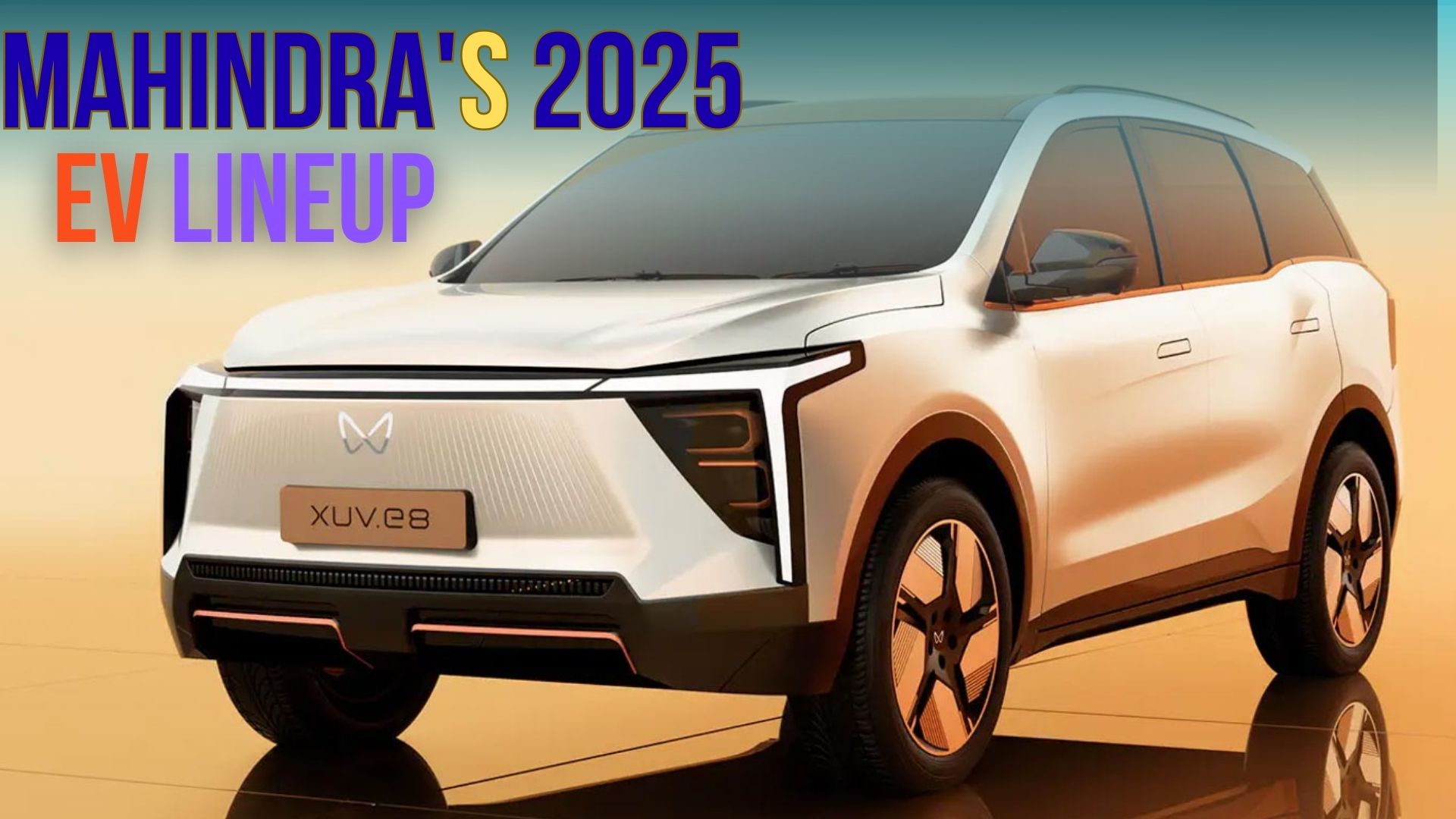Mahindra is making strong relocations in India’s electrical vehicle area with an ambitious 2025 lineup that promises to shake up the market. The homegrown car manufacturer is set to introduce four distinct electric SUVs throughout the year, each targeting various price sectors and customer requirements.

From the premium XEV 9e to the cost effective XUV 3XO EV, Mahindra’s electric portfolio represents among the most comprehensive EV techniques by any Indian maker. These launches come at a crucial time when the Indian EV market is experiencing unprecedented development, with federal government rewards driving adoption and consumer awareness reaching new heights.
Here’s everything you require to learn about Mahindra’s electric SUV offensive that might redefine how Indians consider electrical mobility.
Mahindra BE 6: The Performance-Focused Electric SUV
The Mahindra BE 6 leads the charge with its radical design approach and outstanding efficiency credentials. This electrical SUV represents Mahindra’s vision of what modern-day Indian EVs must look like- bold, powerful, and technologically advanced.
Design and Performance Specs
The BE 6 stands out with its futuristic styling that breaks away from standard SUV design language. Under the hood, it loads major performance numbers that measure up to exceptional European EVs. The top-spec alternative delivers 281 horsepower and 380 Nm of torque, allowing a 0-100 kph sprint time of just 6.7 seconds.
2 battery choices deal with different variety requirements. The entry-level Pack One alternative features a 59kWh battery supplying 556km of ARAI-certified variety, while the flagship version boasts a huge 79kWh battery providing an outstanding 682km range on a single charge.
Rates and Market Position
Starting at Rs 18.90 lakh for the base Pack One version, the BE 6 positions itself as a premium yet accessible electric SUV. The complete price variety extends up to Rs 26.90 lakh, with deliveries expected to start by the end of February 2025.
This prices technique puts the BE 6 in direct competitors with recognized gamers while using exceptional range and efficiency requirements that might provide it a significant one-upmanship.
Mahindra XEV 9e: The Premium Electric Experience
The XEV 9e represents Mahindra’s flagship electric SUV offering, targeting purchasers who desire the supreme in electrical high-end and innovation. Sharing the same platform and powertrain options as the BE 6, the XEV 9e focuses on premium features and improved looks.
Technical Specifications
The XEV 9e mirrors the BE 6’s impressive technical abilities with slight variations in performance tuning. The 0-100 kph velocity time is marginally slower at 6.8 seconds, but the double battery options remain the exact same 59kWh and 79kWh setups.
Variety figures are similarly impressive, with the smaller battery providing 542km and the bigger pack extending that to 656km. These numbers position the XEV 9e amongst the longest-range electrical SUVs offered in India.
Advanced Features and Technology
The XEV 9e comes loaded with cutting-edge functions that justify its premium positioning. The SUV measures 4,789 mm in length, 1,907 mm in width, and 1,694 mm in height, with a wheelbase of 2,775 mm that promises spacious interiors.
Key specifications consist of:
- Ground clearance of 207mm for Indian road conditions
- Boot capability of 663 liters for family requirements
- 245/50 R20 tires for superior road grip
- Quick charging capabilities with up to 175kW DC charging
- AC charging assistance approximately 11kW
Pricing and Competition
The XEV 9e begins at Rs 21.90 lakh and extends as much as Rs 30.50 lakh, placing it strongly in the premium electrical SUV section. Its primary competitors originates from the BYD Atto 3, though the XEV 9e’s remarkable variety and regional production advantage might show decisive aspects for Indian purchasers.
Mahindra XEV 7e: The Three-Row Electric Family SUV
Anticipated to arrive late in 2025, the XEV 7e represents Mahindra’s entry into the three-row electric SUV segment. This model addresses a significant space in the Indian EV market where family-focused electric SUVs with seven-seat ability are virtually non-existent.
Platform and Features
The XEV 7e shares the same INGLO platform as its brother or sisters, ensuring tested dependability and efficiency. It’s basically the electric variation of the popular XUV700, keeping the exact same style language while integrating EV-specific adjustments.
The SUV will likely feature all the innovative technology, security features, and battery options available in the XEV 9e, consisting of the dual-motor AWD setup for boosted efficiency and traction.
Market Positioning
Priced between Rs 20 lakh and Rs 30 lakh, the XEV 7e will contend directly with the upcoming Tata Harrier EV. Its three-row seating setup gives it an unique benefit in the Indian market where big families often choose seven-seater automobiles.
Mahindra XUV 3XO EV: The Affordable Electric Entry Point
The XUV 3XO EV represents Mahindra’s a lot of inexpensive electrical SUV offering, developed to bring electric mobility to the masses. Anticipated to release in mid-2025, this compact SUV maintains the sub-4-meter length restraint while providing excellent electric efficiency.
Style and Interior Features
The XUV 3XO EV closely follows its ICE equivalent’s style approach with EV-specific modifications. Secret modifications consist of a confined front fascia, revamped bumpers, distinctive EV badging, and new alloy wheels that boost aerodynamic performance.
Interior functions mirror the ICE version with copper accents throughout the cabin and roofing, dual-tone black-and-white upholstery, a freestanding touchscreen infotainment system, rotary air conditioning controls, and cordless phone charging capability.
Battery and Performance
Unlike the XUV400 it changes, the XUV 3XO EV advantages from a sub-4-meter kind factor and updated battery technology. The SUV is anticipated to include a 35kWh battery pack, though some versions might use up to 40kWh capability.
Variety expectations are optimistic, with the enhanced aerodynamics and efficient powertrain likely delivering better numbers than the outgoing XUV400’s 375-456km variety figures.
Security and Technology
The XUV 3XO EV acquires comprehensive safety features from its ICE brother or sister, consisting of six airbags, electronic stability control, tire pressure tracking, hill hold help, and a rearview cam.
Advanced motorist support systems (ADAS) functions like lane keep assist and adaptive cruise control are anticipated to be readily available, making this one of the most economical EVs with semi-autonomous capabilities.
Prices and Competition
Anticipated to be priced in between Rs 15 lakh and Rs 20 lakh, the XUV 3XO EV will contend with the Tata Nexon EV and Maruti’s upcoming EVX. Its competitive pricing and detailed feature set could make it a compelling option for first-time EV purchasers.
The Broader Impact on India’s EV Market
Mahindra’s aggressive 2025 EV technique comes at an essential time for India’s electrical car market. The nation is witnessing unmatched development in EV adoption, driven by government rewards, improving charging infrastructure, and growing environmental awareness among consumers.
Market Dynamics and Competition
The Indian EV market is ending up being progressively competitive with multiple makers launching electrical versions of their popular designs. Hyundai introduced the Creta EV in January 2025, while Tata
FAQs
1. What is driving the development of the EV market in India?
A. The growth of the Indian EV market is being sustained by government rewards, a growing concentrate on sustainability, improvements in charging infrastructure, and increasing customer awareness about lowering carbon footprints.
2. Which producers are leading the EV transformation in India?
A. Tata Motors and Hyundai are among the essential players. Tata has been regularly introducing electric versions, while Hyundai introduced the Creta EV in January 2025, marking its strong presence in the market.
3. Exist adequate charging stations readily available in India?
A. India’s charging facilities is quickly expanding, with federal government and personal players teaming up to set up numerous charging stations throughout semi-urban and city locations to accommodate the rising need for EVs.
4. What incentives does the government supply for EV purchasers?
A.The Indian federal government offers aids, tax benefits, and minimized GST rates for electric automobiles to make them more budget-friendly and encourage their adoption.
5. How does the cost of owning an EV compare to a standard automobile?
A. While EVs may have a higher upfront expense, they are more cost-efficient in the long run due to lower fuel and maintenance expenses, and the accessibility of federal government aids even more offsets the initial financial investment.
For More Information CLICK




